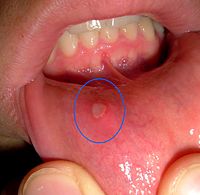
Photo from wikipedia
Clefts of the lip and/or palate (CLP) are visible disruptions of standard facial structure. The aim of our study was to determine a relative number and appearance of the tissue… Click to show full abstract
Clefts of the lip and/or palate (CLP) are visible disruptions of standard facial structure. The aim of our study was to determine a relative number and appearance of the tissue factors in bone of patients with CLP during first time plastic alveolar osteoplasty or rhinoplasty. Immunohistochemistry was performed with matrix metalloproteinase-8 (MMP-8), matrix metalloproteinase-9 (MMP-9), osteopontin (OPN), osteocalcin (OC), Runt-related transcription factor 2 (Runx2), beta-defensin-2 (βdef-2), beta-defensin-3 (βdef-3), interleukin-1 alpha (IL-1α), and interleukin-10 (IL-10). The bone formation was observed by Masson-trichrome (Masson) staining. For the quantification of structures, the semi-quantitative census method was used. Spearman rank order correlation coefficient and Mann-Whitney U test were used for the statistical analysis. A significantly higher number of OPN positive osteocytes was observed in the CLP group when compared to the control group (p=0.002). The number of OC positive osteocytes (p=0.000) and βdef-2 positive osteocytes (p=0.003) was significantly lower in the CLP group in comparison to the control group. Strong, positive correlations between IL-10 and OC (rs=0.608; p=0.002), IL-1α and MMP-9 (rs=0.666; p=0.000), OPN and MMP-8 (rs=0.620; p=0.002) were detected in the CLP group. A tendency for the increased appearance of MMP-8, MMP-9 positive osteocytes of the patients with CLP, suggests elevated tissue remodelling properties. Increased appearance of OPN positive osteocytes in bone of the patients with CLP shows increased bone homeostasis based on seriously decreased mineralization, which may be a possible compensatory reaction to decreased quality of postsurgical bone.
Journal Title: Histology and histopathology
Year Published: 2022
Link to full text (if available)
Share on Social Media: Sign Up to like & get
recommendations!